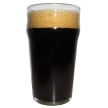| Line 4: | Line 4: | ||
From Wikipedia, the free encyclopedia | From Wikipedia, the free encyclopedia | ||
| − | An empirically derived hydrometer scale developed in 1843 by German scientist Karl Balling, and improved by Fritz Plato to measure density of beer wort in terms of percentage of extract by weight. The scale expresses the density as the percentage of sucrose by weight, so a wort measured at 12° Plato has the same density as a water−sucrose solution containing 12% sucrose by weight. | + | An empirically derived [[hydrometer]] scale developed in 1843 by German scientist Karl Balling, and improved by Fritz Plato to measure density of beer wort in terms of percentage of extract by weight. The scale expresses the density as the percentage of sucrose by weight, so a wort measured at 12° Plato has the same density as a water−sucrose solution containing 12% sucrose by weight. |
| − | For the brewer, it has the advantage over specific gravity that it expresses the measurement in terms of the amount of fermentable materials. | + | For the brewer, it has the advantage over [[specific gravity]] that it expresses the measurement in terms of the amount of fermentable materials. |
Degrees Plato are more popular in central European brewing, and occasionally feature in beer names -- some Slovak or Czech breweries feature 10° and 12° versions of their beers, for instance. Many Belgian breweries also do this, examples include Rochefort and Maredsous | Degrees Plato are more popular in central European brewing, and occasionally feature in beer names -- some Slovak or Czech breweries feature 10° and 12° versions of their beers, for instance. Many Belgian breweries also do this, examples include Rochefort and Maredsous | ||
The relationship between degrees Plato and specific gravity is not linear, but a good approximation is that 1° Plato is worth 4 "brewers points" (the thousandths' part of the SG measurement), so 12° Plato corresponds to an original gravity of 1.048. | The relationship between degrees Plato and specific gravity is not linear, but a good approximation is that 1° Plato is worth 4 "brewers points" (the thousandths' part of the SG measurement), so 12° Plato corresponds to an original gravity of 1.048. | ||
Revision as of 13:14, 1 April 2007
|
This article is a stub.
|

|
From Wikipedia, the free encyclopedia
An empirically derived hydrometer scale developed in 1843 by German scientist Karl Balling, and improved by Fritz Plato to measure density of beer wort in terms of percentage of extract by weight. The scale expresses the density as the percentage of sucrose by weight, so a wort measured at 12° Plato has the same density as a water−sucrose solution containing 12% sucrose by weight.
For the brewer, it has the advantage over specific gravity that it expresses the measurement in terms of the amount of fermentable materials.
Degrees Plato are more popular in central European brewing, and occasionally feature in beer names -- some Slovak or Czech breweries feature 10° and 12° versions of their beers, for instance. Many Belgian breweries also do this, examples include Rochefort and Maredsous
The relationship between degrees Plato and specific gravity is not linear, but a good approximation is that 1° Plato is worth 4 "brewers points" (the thousandths' part of the SG measurement), so 12° Plato corresponds to an original gravity of 1.048.
